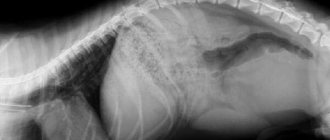Mycoplasmosis in dogs: what is it?
Mycoplasma infection in dogs is a disease caused primarily by microorganisms of the genus Mycoplasma cynos. The pathogen parasitizes the mucous membranes of the visual, respiratory, gastrointestinal and genitourinary tracts. Mycoplasmas feed on the epithelial cells to which they attach.
Has your dog already been tested for mycoplasmosis?
Yes
84.06%
No
15.94%
During their life, membrane parasites release ammonia and hydrogen peroxide, which disrupt the normal functioning of the affected tissues.
With strong immunity and the absence of chronic pathologies, mycoplasmosis occurs in a latent (hidden) form. In puppies, elderly and weakened individuals, the infection, depending on the location of the pathogen, manifests itself as conjunctivitis, diseases of the genitourinary, respiratory systems, gastrointestinal tract and musculoskeletal system.
Mycoplasmas live in the body of most healthy dogs. Membrane pathogens cause the disease in only 10-15% of infected animals.
Is it transmitted to humans and other animals?
Mycoplasmas that infect dogs and cats are not dangerous to humans. There are no recorded cases in medicine where a dog infected a person. But it is still recommended to pay more attention to personal hygiene: wash your hands after interacting with your pet, when feeding and cleaning its things. It is also better to protect people with weakened immune systems from communicating with dogs: the elderly and children, as well as people susceptible to chronic diseases or who have just suffered from an illness.
REFERENCE! Mycoplasmas are transmitted only within one organic species. In other words, from animal to animal, or from person to person.
Routes of infection
The main carriers of the disease in the environment are mice and rats. Rodents are carriers of mycoplasmas and can infect dogs through airborne droplets, contact, or through contaminated food.
The infection can also be transmitted during the mating process between a dog and a bitch if one of the animals is infected. Mycoplasmosis is often transmitted to puppies through birth. Intrauterine infection is also possible, which causes fetal death.
In infected dogs with strong immunity, mycoplasmosis is asymptomatic. They are carriers, release the pathogen into the environment and are potentially dangerous to other animals.
Diagnostics
Diagnosis of mycoplasmosis is impossible only by clinical signs, even for the most experienced veterinarian. This disease can only be identified using laboratory diagnostic methods.
- The main diagnostic method is PCR, which allows you to identify the pathogen.
- RIF (immunofluorescence reaction) - detection of pathogen antigens.
- ELISA (enzyme-linked immunosorbent assay) – detection of pathogen antibodies.
- Wash from the trachea, wash from the bronchus, smears.
The detection of mycoplasmas does not mean that the animal has mycoplasmosis, since healthy animals normally have mycoplasmas.
Symptoms of the disease
The symptoms of mycoplasmosis depend on the location of the membrane parasite. Most often, the pathogen affects the mucous membrane of the eyes, which leads to the development of conjunctivitis. Inflammation of the conjunctiva can be either unilateral or bilateral. Accompanied by lacrimation, swelling of the eyelids, serous or purulent discharge.
Mycoplasmas settled in the respiratory organs lead to the development of rhinitis, bronchitis, and pneumonia. Often the disease is combined with adenovirus in dogs. If the respiratory system is affected, the animal experiences a runny nose, sneezing, and coughing.
Often mycoplasmosis in dogs affects the mucous membranes of the mouth, leading to the development of gingivitis, accompanied by inflammation and bleeding of the gums.
With the development of infection in the urogenital tract, vaginitis is observed in females, and balanoposthitis and prostatitis in males. Sexual diseases are characterized by discharge of various types from the vulva or urethra.
Mycoplasmosis occurring in the urinary organs manifests itself as urethritis, pyelonephritis or cystitis in dogs. The first symptoms of urinary system infections are frequent and scanty urge to urinate, restless behavior of the pet.
Pathogens that settle on the skin cause itchy dermatoses with varying degrees of severity.
When the joints are affected, symptoms of arthritis are observed: the dog limps (usually on one leg) and refuses to step on the affected limb. Signs of lameness are not present all the time and appear from time to time.
In females infected with mycoplasma, miscarriages and stillbirths are often recorded.
Common signs of mycoplasma infection include: fever, lethargy, lethargy, and poor appetite. When the gastrointestinal tract is affected, vomiting and diarrhea in dogs are observed.
Clinical picture
Until the necessary diagnostic tests are carried out, it is not possible to determine mycoplasma infection. The pathology is manifested by symptoms inherent in a specific disease caused by damage to a specific organ by Mycoplasma cynos.
The owner should be alert to the following signs:
- redness and suppuration of the eyes, increased lacrimation;
- runny nose;
- stomach pain, diarrhea, or constipation;
- problems with urination;
- nausea, vomiting;
- high temperature, fever;
- pain and swelling of the joints, lameness;
- poor appetite or lack thereof;
- low mobility, apathy;
- anemia;
- skin rashes (dermatitis, eczema, dermatosis).
The blurred clinical picture and similarity with other pathologies makes diagnosis difficult.
Consequences of mycoplasmosis in dogs
When the conjunctiva becomes inflamed against the background of mycoplasmosis in dogs, a secondary infection may occur. For example, with inflammation of the conjunctiva, purulent conjunctivitis often develops. An ophthalmological disease, in the absence of proper treatment, causes visual impairment (cataracts, glaucoma).
A long course of mycoplasma bronchitis is dangerous due to the development of obstructive pulmonary disease.
When the oral cavity is damaged, chronic gingivitis can develop, which in turn becomes the cause of periodontal disease. Due to dental disease, complete or partial loss of teeth occurs.
Mycoplasma arthritis leads to the destruction of cartilage tissue and the formation of erosions on the surface of the joint.
In sick bitches with mycoplasmosis, pregnancy is often terminated and underdeveloped puppies are born. There is also a high mortality rate of offspring in the first days after birth.
Hemotrophic mycoplasmosis, which affects blood cells, causes the development of anemia in animals.
Why choose InTime?
Qualified specialists
The InTime clinic employs urologists-andrologists of the highest category, professors, doctors of medical sciences. Our doctors treat mycoplasmosis in men and women using the latest methods, which guarantees complete recovery.
Service and comfort
We accept appointments by appointment. The InTime clinic has comfortable waiting rooms with comfortable furniture, modern operating rooms and manipulation rooms, as well as cozy hospital rooms.
Modern equipment
The InTime clinic uses the latest generation of equipment from leading foreign and domestic manufacturers. To diagnose diseases associated with mycoplasmosis, ultrasound machines Mindray DC-3, iU 22 with 4 and GE LogiqC5, and video colposcopes Dr. Camscope DCSM and SLV-101 are used.
Own laboratory
All studies are carried out in the InTime clinic’s own laboratory using German and Japanese equipment. This allows you to obtain reliable results in a short time.
Complete security
All rooms are regularly treated with an ORUBp-3-5-KRONT irradiator-recirculator, and therefore are absolutely sterile. In our work we use only disposable consumables from leading manufacturers.
Convenient location
It’s easy to get to us - the InTime clinic is located next to the Third Transport Ring. Nearby are the Frunzenskaya, Park Kultury and Sportivnaya metro stations.
Diagnostic measures
The most effective method for diagnosing mycoplasma infection is PCR (polymer chain reaction). If mycoplasmosis is suspected, swabs are taken from the dog’s conjunctiva and swabs are made from the mucous membranes of the genital and respiratory organs (depending on the location of the infectious process). The effectiveness of PCR is largely determined by the quality of the collection of research material.
A urine test in the presence of pathogens in the genitourinary system can also be informative. Blood sampling is carried out to determine the sensitivity of mycoplasmas to certain antibiotics.
Why is mycoplasmosis dangerous?
With self-treatment, without consultation and prescription of drugs directly by a veterinarian, there is a high probability that mycoplasmas will develop immunity to the drugs and antibiotics used. In addition, most drugs have a negative effect on the liver, and without the right medications, the animal can die from failure.
REMEMBER! This disease practically destroys the pet’s immune system, so the course of treatment and recovery must be carefully selected!
If mycoplasmosis is treated carelessly or incorrectly, the likelihood of complications is high: there is a risk of the dog becoming infected with enteritis, hepatitis and canine distemper. These infectious diseases are much more difficult to treat and often lead to the death of the animal.
Treatment regimen for mycoplasmosis
There is no single treatment regimen for mycoplasma infection. The approach to therapy depends on the severity of the disease and the location of the membrane parasites. The dog must be prescribed:
- antibiotics;
- hepatoprotectors;
- immunomodulators;
- probiotics or prebiotics.
Mycoplasmas are sensitive to antibacterial drugs of the group of amphenicols (Levomycetin), macrolides (erythromycin), tetracyclines (Doxycycline), fluoroquinolones (Ofloxacin, Enroxil).
Since pathogenic microorganisms quickly develop resistance to antibiotics, a combination of drugs is prescribed.
The duration of treatment can vary from 1 to 3 weeks and is strictly determined by the doctor. After completing the course of antibiotics, the dog is prescribed repeat tests.
For infections of the respiratory, genitourinary, and digestive systems that occur against the background of mycoplasmosis, a combination drug with antibacterial and antiviral action, Ribaflox, can be prescribed.
Long-term use of antibiotics negatively affects liver function. Therefore, dogs are recommended to use hepatoprotectors (Hepatovet, Hepatiale Forte, Hepatolux, etc.). Duration of use is from 3 to 5 weeks.
Treatment of mycoplasmosis, which occurs simultaneously with a viral infection, is reduced to the additional use of antiviral drugs (Ribavirin, Maxidin 0.4).
Among the immunomodulators, the animal can be prescribed Gamavit, Azoxyvet, Fosprenil, etc.
Probiotics for dogs (Fortiflora, Lactoferon, Vetom 1) are prescribed after antibacterial therapy to restore the intestinal microbiota and stimulate the immune system.
With the development of mycoplasma conjunctivitis, topical medications in the form of drops (Tsiprovet) or ointments (Tetracycline 1%) are indicated.
In case of cystitis against the background of mycoplasmosis, in addition to antibiotics, herbal medicine is additionally indicated, which has an anti-inflammatory and diuretic effect (Stop-Cystitis, Kotervin, Cyston).
For vaginitis and balanoposthitis, rinsing with antiseptic solutions (Miramistin, Chlorhexidine) and applying local antibacterial ointments (tetracycline, chloramphenicol, etc.) are prescribed.
The use of steroid ointments for urogenital diseases against the background of mycoplasmosis is contraindicated.
With the development of mycoplasma arthritis, it is necessary to take anti-inflammatory drugs with an analgesic effect (suspension or tablets of Sinulox for dogs, as well as its analogues) and chondroprotectors (tablets Artroglycan, Kanvit Chondro, Stride Plus).
A sick animal must be isolated from other pets.
Immunity to mycoplasmosis in dogs is usually short-lived. A weakened animal can become infected again. The cause of relapse is also the species diversity of the pathogen.
Prevention
Mycoplasmas are not dangerous for healthy and active dogs that receive complete and proper nutrition and also exercise regularly.
Therefore, preventive actions include:
- Maintaining high-quality living conditions for the dog, proper thermal conditions, hygiene and care for it, as well as ensuring good physical activity for the pet;
- Regular examinations and examinations by a veterinarian;
- Limiting contact with animals that could potentially be infected: stray dogs, cats and rodents;
- Conditioning and monitoring your pet while walking: young animals or animals that have not completed a general training course often pick up garbage and leftovers from the ground;
- Regular vaccinations and treatments against parasites in accordance with a special schedule;
- Examination for the presence of mycoplasmas before mating (for both females and males);
- Availability of complete nutrition for the dog, including various vitamin and mineral complexes;
- Regular disinfection of the premises when keeping dogs in a kennel or shelter.
REFERENCE! Unfortunately, there is no vaccine against mycoplasmosis in dogs.
Remember that with an active life and proper care, as well as receiving the care and love of the owner, your pet will always be happy and healthy.
Ureaplasmosis
Ureaplasma is an opportunistic microorganism that for many women represents normal vaginal flora. When the content of ureaplasma exceeds the permissible norms and causes inflammation in the genitourinary tract, we are talking about a disease called urogenital ureaplasmosis.
Men are less likely to suffer from ureaplasmosis. The incubation period of ureaplasmosis lasts from 15 to 45 days. If the infected person does not have an inflammatory process, then treatment is not prescribed. This feature of ureaplasmosis and mycoplasmosis distinguishes them from diseases such as chlamydia and trichomoniasis, which require immediate treatment.
Like other STI diseases, ureaplasmosis can have acute and chronic forms. The acute form of ureaplasmosis manifests itself much more clearly, and it is much easier to treat. Untimely treatment leads to chronic ureaplasmosis, which is much more difficult to treat.
The main causes of ureaplasmosis are any type of sexual contact with an infected person, as well as transmission of the infection to the child from the mother during pregnancy and childbirth. Infection is possible during organ and tissue transplantation.
Symptoms of ureaplasmosis
Ureaplasmosis infection is asymptomatic for a long time.
The main signs of ureaplasmosis in men:
- slight itching in the urethra, which intensifies with urination;
- small cloudy discharge that appears when the distant parts of the urethra are involved;
- when the ureaplasmosis infection invades the prostate tissue, signs of prostatitis appear - nagging pain in the perineum, possible erectile dysfunction, decreased libido;
- redness and burning in the head area, which intensifies when warming up;
- When the bladder becomes infected, signs of cystitis appear (frequent urination first).











